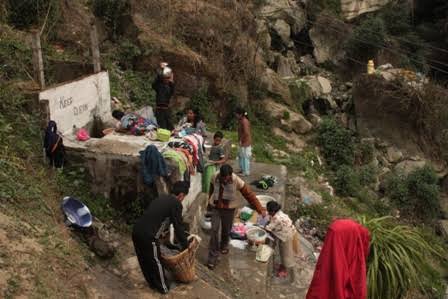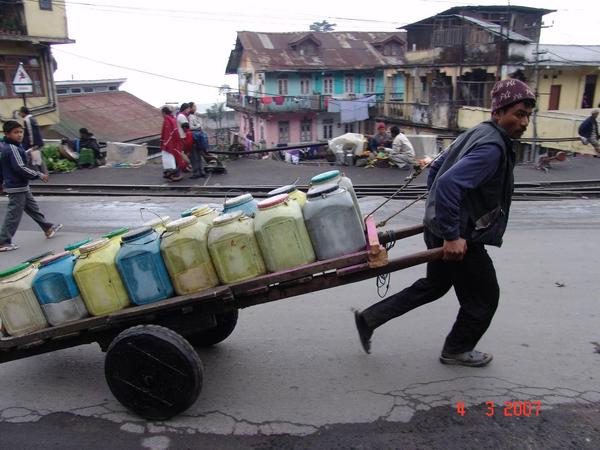Drinking water problem in Darjeeling has been a sore wound that has refused to heal for over two decades now. After re-elected for the second consecutive term, Prime Minister Narendra Modi power in the centre, the first ‘Maan ki Baat’ radio broadcast aired on June 7, where, in his address, the Prime Minister conveyed the message to the nation that every part of the nation must pay more attention to the current water crisis and water conservation options.
Water as we considered as life on the earth. Without water, it would be impossible to imagine human life as well as all creations. Total 71% of the earth covered by the water. Out of this 71%, 97 per cent water contains in the giant oceans which have a salty taste and not fit for drinking. Now remaining of 3% of 71%; which we can consider as a source of drinking water, 2.997% of water remains in solid form in the glaciers. Hence only 0.003% of water is drinkable or in the solid-state for consumption.
Unfortunately, now we have a bizarre form of drinking water crisis created by the various form of man-made pollution. Every part of our country struggles with water crisis every year. For the past few years, the Chennai metropolis has been struggling with a complex shortage of drinking water, which remains the same in this year also.
Due to the water crisis, farmers’ suicide, drought, the crisis of drinking water etc are the major issues which we witnessed every year.
According to the United Nations report on water conservation, within 2030, 40% of India’s population have to struggle for drinking water while by the year 2040 in most parts of Indian cities the problem of drinking water can get even worse than ever.
Darjeeling’s drinking water problem is not recent. Darjeeling’s water crisis, which has been steadily increasing over the past decade, is now taking a tumultuous year. The irony, however, is that the residents, as well as the concerned parties, are not taking alarming water crisis so deeply. Every year, in the dry season, there is a rush of drinking water, and then it all gets disappeared. Then next year, when water shortages occur, then again everyone gets their attention on water problems.
The source of drinking water for the town of Darjeeling, which has been distributed by the Darjeeling Municipality, is the Sinchel Lake, located in Ghoom-Jorebunglow region. The North Lake, located at Sinchel, was built in 1910 and the South-Lake in 1932, under the leadership of Thos Kenay, the first engineer (engineer) of the then Darjeeling Municipality. Darjeeling town has been getting drinking water from this pair of ponds at Senchel since February 28, 1932.
Also, according to the report of the Darjeeling Municipality year of 2010, the third lake, constructed in 1978, Siddhap Lake also has a capacity of drinking about 1 million gallons. However, due to lack of proper reservoir and lack of proper management less than a half per cent of water been carried through this newly constructed water reservoirs.
Kang-Khola is also another source from which about 5,000 gallons of water been extracted to deal with shortages in the dry season.
In addition to this, the drinking water of Darjeeling town is provided by small natural reservoirs, around the city including the Rambi catchment area.
Also, to solve the drinking water problem for Darjeeling permanently, Balasan Project has been running as its foundation stone been laid in the year 2006. The Balasan project worth of billions of rupees been completed lately. Unfortunately, according to the statement made by PHE department officials stated that ‘under the Balansan project from Silchar Lake, approximately 1,750 meters, water needs to be pumped to reach in Darjeeling town. As a result, the department will have to incur an additional load of Rs. 10 million every year on electricity consumption’.
In another word, the Balasan project seems to have failed in one way and could not solve Darjeeling’s drinking water problem at the end. At the same time, it is understood that even after spending billions of rupees it has not provided a concrete solution of the hills.
Later on, recent year only, local administration GTA submitted a proposal to the state’s chief minister for a project that could cost around Rs. 750 Crore, including the Detail Project Report (DPR), keeping given the drinking water problem in Darjeeling, Kurseong and Kalimpong. Under this project it has been proposed that about 107 km of pipeline from Siri-Khola would arrange to draw water to the town of Darjeeling, which is estimated to cost around Rs. 105 Crore (for Darjeeling only).
At present, the Darjeeling Municipality has begun laying new and advanced quality of pipelines in all areas of the municipality. Its main purpose is to stop the tradition of connecting illegal water lines in the main pipelines, repairing old pipelines, and supplying water to every municipal ward under collective management.

Given the current drinking water crisis in the city of Darjeeling, I would like to put a few suggestions along with the major factors been observed behind the water crisis of the hills:
- The reservoirs located in the Sinchel were built by the British for a population of about 25,000 to 30,000 population in the town. At that time, there were about 26 streams in the catchment area for the irrigation of drinking water. So, with the destruction of more forests around Sinchel catchment area, as well as the expanding area of developmental works, currently, there are only five to six water sources permanently (throughout the season). Its number reaches till ten during monsoon as it also depends on the annual rainfall pattern of the hill. As a result, water will now have to be transported from other sources to meet the town’s drinking water consumption demands.
- There has been a huge difference in the demand and supply of water. According to the 2011-census, Darjeeling town’s population is about 120414 (one lakh twenty thousand four hundred fourteen). Also, the number of tourists entered here daily, the number of students who are studying in schools and colleges here; as well as the number of residents coming to Darjeeling town from adjoining areas results, the daily load of the city of Darjeeling is estimated to be more than 2 lakh.
- In such a situation, the demand for drinking water goes up automatically and we do not have a concrete solution of it for last.
- According to the report of the National Forest Policy, within the last few decades, 20-22 per cent of Darjeeling forest has been destroyed as a result of deforestation, development and expansion work and for daily living. The way vegetation has been lost is something alarming for local existence. The destruction of forests at such a rapid pace at mountainous geographical slopes might raise a big question mark on our existence in near future because trees hold all types of soils in the slope, as well as trees, act as water reservoirs in the hills.
- The entire north-eastern Himalayas, including Darjeeling, receive maximum rainfall. In Darjeeling, an average of approx 2812 millimetres of rainfall occurs every year.
- Even though there is a huge scarcity of drinking water. It proves that we are still not aware of water management skills as well as various techniques (steps) of the utilization of rainwater. The widespread use of rainwater harvesting projects and related issues can be resolved water crisis to a lesser extent. An example, we can take from the Indian state of Tamil Nadu. Tamil Nadu is the first state in India where every household must adopt rainwater harvesting system. The irony is, the current scenario of Tamil Nadu (especially Chennai) water crisis is creating havoc situation. Presently, management of rainwater harvesting is a must in every new house or building construction work in Pune district of Maharashtra. We have a good option to fight the battle with water crisis implementing rainwater harvesting or water management techniques in the near future. Even local municipality can initiate to make reservoirs nearby town where we can collect rainwater harvested from various areas of the town itself,
- Repair of many old reservoirs as well as replacement of the old pipelines that have been laid years ago can prevent wasteful water treatment. Due to poor water channels, it has been observed that precious water been wasted daily basis in huge amount. These loop-holes can be prevented by implementing a new water distribution system or by regular monitoring of the existing distribution channels.
- Another major reason behind Darjeeling’s drinking water problem is the privatization and commercialization of water sources. The proximity of the water to the water sources is not uniformly reached due to the right and authority of the surrounding water sources or streams are not common. Usually, it is capable and accessible for a few people or communities only for the sake of commercialization and privatization of water bodies. The concerned authority, mainly the Forest Department and PHE department, needs to take necessary steps to resolve this disparity among society.
- It has been said that education builds society! Every school has assigned subject-based projects for the students. Focusing the hills schools, I would propose that, if our local schools assign projects related to our local issues and ecological demands. It can be environmental, social, and economical or any other related to our own; it can create awareness among our upcoming generation. Who knows, our brightest minds might come with permanent solutions for our issues! Let them indulge with our local issues rather than doing copy-paste works from the internet in the name of various projects.
- In the end, the problem of drinking water in Darjeeling District is very old and this chronic problem has already consumed billions of rupees of our own. Unfortunately, it still doesn’t seem to have a solid solution. For this, the need of the hour is, we all have to come together for the solution. The concerned agencies, administration, various stakeholders of the hills, NGOs, educational institutions and the general public must come together on the same table and need to seek effective solutions with cooperation.
Writes: Noel Giri






Leave a comment